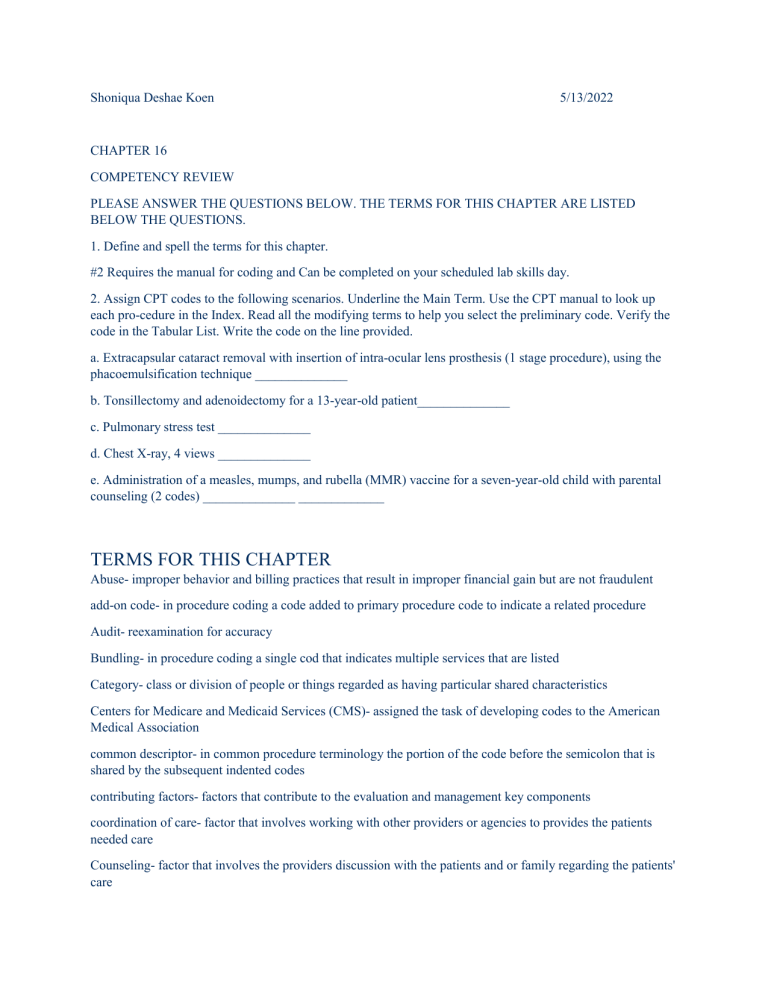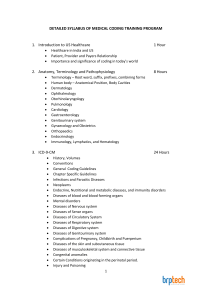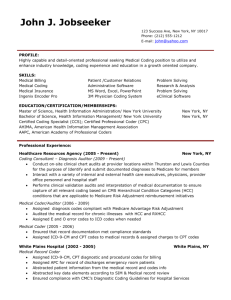
Shoniqua Deshae Koen 5/13/2022 CHAPTER 16 COMPETENCY REVIEW PLEASE ANSWER THE QUESTIONS BELOW. THE TERMS FOR THIS CHAPTER ARE LISTED BELOW THE QUESTIONS. 1. Define and spell the terms for this chapter. #2 Requires the manual for coding and Can be completed on your scheduled lab skills day. 2. Assign CPT codes to the following scenarios. Underline the Main Term. Use the CPT manual to look up each pro-cedure in the Index. Read all the modifying terms to help you select the preliminary code. Verify the code in the Tabular List. Write the code on the line provided. a. Extracapsular cataract removal with insertion of intra-ocular lens prosthesis (1 stage procedure), using the phacoemulsification technique ______________ b. Tonsillectomy and adenoidectomy for a 13-year-old patient______________ c. Pulmonary stress test ______________ d. Chest X-ray, 4 views ______________ e. Administration of a measles, mumps, and rubella (MMR) vaccine for a seven-year-old child with parental counseling (2 codes) ______________ _____________ TERMS FOR THIS CHAPTER Abuse- improper behavior and billing practices that result in improper financial gain but are not fraudulent add-on code- in procedure coding a code added to primary procedure code to indicate a related procedure Audit- reexamination for accuracy Bundling- in procedure coding a single cod that indicates multiple services that are listed Category- class or division of people or things regarded as having particular shared characteristics Centers for Medicare and Medicaid Services (CMS)- assigned the task of developing codes to the American Medical Association common descriptor- in common procedure terminology the portion of the code before the semicolon that is shared by the subsequent indented codes contributing factors- factors that contribute to the evaluation and management key components coordination of care- factor that involves working with other providers or agencies to provides the patients needed care Counseling- factor that involves the providers discussion with the patients and or family regarding the patients' care Current Procedural Terminology (CPT®)- a listing of five-character alphanumeric codes and descriptions used to report outpatient medical services and procedures Downcoding- coding for a lower level of service than what was actually provided, to avoid potential fraud or abuse Edits- specific coding and billing criteria that are checked for accuracy based on predetermined rules established patient- who has been seen in the past 3 years Evaluation and Management (E&M)- codes for services such as office visits, consultation, emergency services examination (E, Ex)- describes the complexity of the physical assessment of the patient face-to-face time- indication of the amount of time the physician typically spends with the patient or family Fraud- the act of intentionally billing for services that were never given or billing for a service that has a higher reimbursement than the service actually provided global period- the number of days that surrounding a surgical procedure during which all services relating to that procedure during which all services related to that procedure were preformed Guidelines- the instructions that appear at the beginning of each section and apply to all codes in the section Healthcare Common Procedure Coding System (HCPCS)- a set of codes developed and maintained by the centers for Medicare and Medicaid services for the reporting of professional services nonphysician history (H, Hx)- a key component that describes the background onset and progression of the patient's current condition indented code- description is indented three spaces and begins with a small letter Index-lists procedures and services in the CPT manual alphabetically instructional notes- notes that appear in () parentheses and the direct user to alternative codes for closely related procedures key component- one of the three categories of criteria used for code selection Level I codes- The HCPCS designates, for Medicare and Medicaid, the CPT codes level one codes for professional services Level II codes- The HCPCS designates for Medicare and Medicaid a set of alphanumeric codes that begin with a letter followed by four numbers Main Term- aid in locating the most appropriate code or range of codes medical decision making (MDM)- a key component that describes the complexity of establishing a diagnosis and or selecting a management option medical necessity- diagnosis codes are required to explain the reasons for the encounter or the reason services were provided Modifiers- a person or thing that makes partial or minor changes to something modifying term aid in locating the most appropriate code or range of codes new patient- Patient who has never been seen by anyone in the practice Outpatient- Services provided to a patient on a walk-basis whin no overnight parent code—see standalone code- one whose description is left-justified and begins with a capital letter patient status- Designation of a patient as a new patient or an established patient presenting problem- a contributing factor, the primary reason the patient is seeing the provider procedure coding- the act of assigning alphanumeric characters to the procedures and services that physicians and health care facilities provide to patients Procedures- an established or official way of doing something professional component- In coding of radiology he performance of imaging is the technical component relative value unit (RVU)- designed to provide relative economic values for medical care based on the cost of providing services categorized as physician work, practice expense, and professional liability resequenced code- new code is added to a family of codes but a sequential number is unavailable Section- any of the more or less distinct parts into which something is or may be divided or from which it is made up semicolon (😉- indented code descriptions- the portion of a procedure description that is shared by more than one indented code appears before a semicolon special instructions- Directions within each section of a coding manual describing specific rules and definitions standalone code- one whose description is left-justified and begins with a capital letter Subcategory- A level of code numbers having a four or five character Subheading- In the hierarchy of a coding manual, the tabula list is divided into sections Subsection- divided into sections surgical package- Codes include the surgical package includes specific services in addition to the surgery itself that cannot be billed separately Tabular List- numerical listing of all CPT codes, divided into Category I, Category II, and Category III technical component- the performance of the imaging is the technical component, the review and analysis of the results by qualified physicians Unbundling- Separately for related procedures that were performed together and by law must by billed as one charge Upcoding- which is coding for a higher level of service than what was actually provided to gain higher reimbursement


